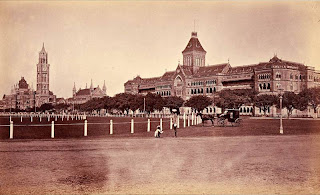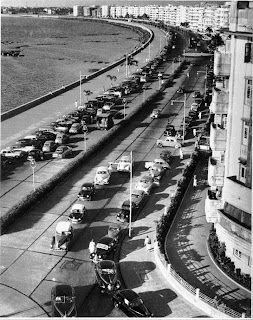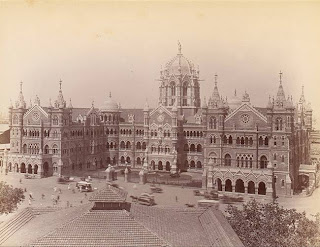The history of Mumbai
Mumbai, formerly known as Bombay, is the capital of the Indian state of Maharashtra. The name Mumbai is derived from Mumba the name of the Koli goddess Mumbadevi. The name Bombay was possibly originated as the Old Portuguese phrase bom baim, meaning "good little bay".
It is the most populous city in India, and the second most populous city in the world, with a population of approximately 14 million. Mumbai lies on the west coast of India and has a deep natural harbor. Mumbai is also the richest city in India, and has the highest GDP of any city in South, West or Central Asia.
The city of Mumbai originally consisted of seven islands, namely Bombay Island, Parel, Mazagaon, Mahim, Colaba, Worli, and Old Woman's Island (also known as Little Colaba)
Pleistocene sediments found along the coastal areas around Kandivali in northern Mumbai by archaeologist Todd in 1939 suggest that these islands were inhabited since the Stone Age. It is not exactly known when these islands were first inhabited. Perhaps at the beginning of the Common era (2000 years ago), or even possibly earlier, they came to be occupied by the Koli fishing community.
In the third century BCE, the islands formed part of the Maurya Empire, during its expansion in the south, ruled by the Buddhist emperor, Ashoka of Magadha. The Kanheri Caves in Borivali were excavated in the mid-third century BCE, and served as an important centre of Buddhism in Western India during ancient times. The city then was known as Heptanesia.
After his death, these islands passed into the hands of various Hindu rulers until 1343. In that year, the Mohammedans of Gujarat took possession and the Kings of that province of India ruled for the next two centuries. The only vestige (mark) of their dominion over these islands that remains today is the mosque at Mahim.
Between the second century BCE and ninth century CE, the islands came under the control of successive indigenous dynasties: Satavahanas, Western Kshatrapas, Abhiras, Vakatakas, Kalachuris, Konkan Mauryas, Chalukyas and Rashtrakutas, before being ruled by the Silhara dynasty from 810 to 1260. Some of the oldest edifices in the city built during this period are, Jogeshwari Caves (between 520 to 525), Elephanta Caves (between the sixth to seventh century), Walkeshwar Temple (10th century), and Banganga Tank (12th century).
King Bhimdev founded his kingdom in the region in the late 13th century, and established his capital in Mahikawati (present day Mahim). The Delhi Sultanate annexed the islands in 1347–48, and controlled it till 1407. During this time, the islands were administered by the Muslim Governors of Gujarat, who were appointed by the Delhi Sultanate.
The islands were later governed by the independent Gujarat Sultanate, which was established in 1407. The Sultanate's patronage led to the construction of many mosques, prominent being the Haji Ali Dargah in Worli, built in honour of the Muslim saint Haji Ali in 1431.
In 1534 the Portuguese, who already possessed many important trading centers on the western coast, such as Panjim, Daman, and Diu, took Bombay by force of arms from the Mohammedans. The Portuguese were actively involved in the foundation and growth of their Roman Catholic religious orders in Bombay. This led to the establishment of numerous churches which were constructed in areas where the majority of people were Roman Catholics.
Some of the oldest Catholic churches in the city such as the St. Michael's Church at Mahim (1534), St. John the Baptist Church at Andheri (1579), St. Andrew's Church at Bandra (1580), and Gloria Church at Byculla (1632), date from the Portuguese era.
The Portuguese also fortified their possession by building forts at Sion, Mahim, Bandra, and Bassien which, although in disrepair, can still be seen. They named their new possession as "Bom Baia" which in Portuguese means "Good Bay".
On 11 May 1661, the marriage treaty of English King Charles II and Catherine of Braganza, daughter of King John IV of Portugal, placed the islands in possession of the British Empire, as part of Catherine's dowry to Charles. However, Salsette, Bassein, Mazagaon, Parel, Worli, Sion, Dharavi, and Wadala still remained under Portuguese possession. From 1665 to 1666, the British managed to acquire Mahim, Sion, Dharavi, and Wadala.
In the year 1668 the islands were acquired by the English East India Company on lease from the crown for an annual sum of 10 pounds in gold; so little did the British value these islands at that time. The population quickly rose from 10,000 in 1661, to 60,000 in 1675. The islands were subsequently attacked by Yakut Khan, the Siddi admiral of the Mughal Empire, in October 1672, Rickloffe van Goen, the Governor-General of Dutch India on 20 February 1673, and Siddi admiral Sambal on 10 October 1673.
The East India Company transferred its headquarters from Surat to Bombay. The shifting of the East India Company's headquarters to Bombay in 1687 led to the eclipse of Surat as a principal trading center. The British corrupted the Portuguese name "Bom Baia" to "Bombay". The Kolis used to call the islands "Mumba" after Mumbadevi, the Hindu deity to whom a temple is dedicated at Babulnath near Chowpatty's sandy beaches.
Towards the end of the 17th century, the islands again suffered incursions from Yakut Khan in 1689–90. The Portuguese presence ended in Bombay when the Marathas under Peshwa Baji Rao I captured Salsette in 1737, and Bassein in 1739.
By the middle of the 18th century, Bombay began to grow into a major trading town, and received a huge influx of migrants from across India. Later, the British occupied Salsette on 28 December 1774. With the Treaty of Surat (1775), the British formally gained control of Salsette and Bassein, resulting in the First Anglo-Maratha War.[67] The British were able to secure Salsette from the Marathas without violence through the Treaty of Purandar (1776), and later through the Treaty of Salbai (1782), signed to settle the outcome of the First Anglo-Maratha War.
From 1782 onwards, the city was reshaped with large-scale civil engineering projects aimed at merging all the seven islands into a single amalgamated mass. This project, known as Hornby Vellard, was completed by 1784. In 1817, the British East India Company under Mount stuart Elphinstone defeated Baji Rao II, the last of the Maratha Peshwa in the Battle of Khadki. Following his defeat, almost the whole of the Deccan came under British suzerainty, and were incorporated in Bombay Presidency.
By 1845, the seven islands were coalesced into a single landmass by the Hornby Vellard project. Sir Robert Grant (1779-1838) governed Bombay from 1835 to 1838 and was responsible for the construction of a number of roads between Bombay and the hinterland. The Thana and Colaba Causeways were built during his tenure as well as the Grant Medical College attached to the Sir Jamshedji Jeejeebhoy (J.J.) Group of hospitals.
On 16 April 1853, India's first passenger railway line was established, connecting Bombay to the neighbouring town of Thane. The Great Indian Peninsular (GIP) and the Bombay Baroda and Central India (BB&CI) Railway were started in 1860 and a regular service of steamers on the west coast was commenced in 1869. Also during this period Bombay enjoyed great economic wealth. he opening of the Suez Canal in 1869 brought the West closer to Bombay, and as the city became more prosperous, many schemes were launched for reclaiming additional land and building more roads and wharves. Bombay began to attract fortune hunters by the hundreds and the population had swelled from 13,726 in 1780 to 644,405 in 1872, in a little less than a hundred years. By 1906 the population of Bombay was to become 977,822.
After India's independence in 1947, the territory of the Bombay Presidency retained by India was restructured into Bombay State. The area of Bombay State increased, after several erstwhile princely states that joined the Indian union were integrated into Bombay State. Subsequently, the city became the capital of Bombay State. On April 1950, Municipal limits of Bombay were expanded by merging the Bombay Suburban District and Bombay City to form Greater Bombay Municipal Corporation.
The Samyukta Maharashtra movement to create a separate Maharashtra state including Bombay was at its height in the 1950s. In the Lok Sabha discussions in 1955, the Congress party demanded that the city be constituted as an autonomous city-state. The States Reorganisation Committee recommended a bilingual state for Maharashtra–Gujarat with Bombay as its capital in its 1955 report. Bombay Citizens' Committee, an advocacy group comprising of leading Gujarati industrialists lobbied for Bombay's independent status.
Following protests during the movement in which 105 people were killed by police, Bombay State was reorganised on linguistic lines on 1 May 1960. Gujarati-speaking areas of Bombay State were partitioned into the state of Gujarat. Maharashtra State with Bombay as its capital was formed with the merger of Marathi-speaking areas of Bombay State, eight districts from Central Provinces and Berar, five districts from Hyderabad State, and numerous princely states enclosed between them. As a memorial to the martyrs of the Samyukta Maharashtra movement, Flora Fountain was renamed as Hutatma Chowk(Martyr's Square), and a memorial was erected.
























